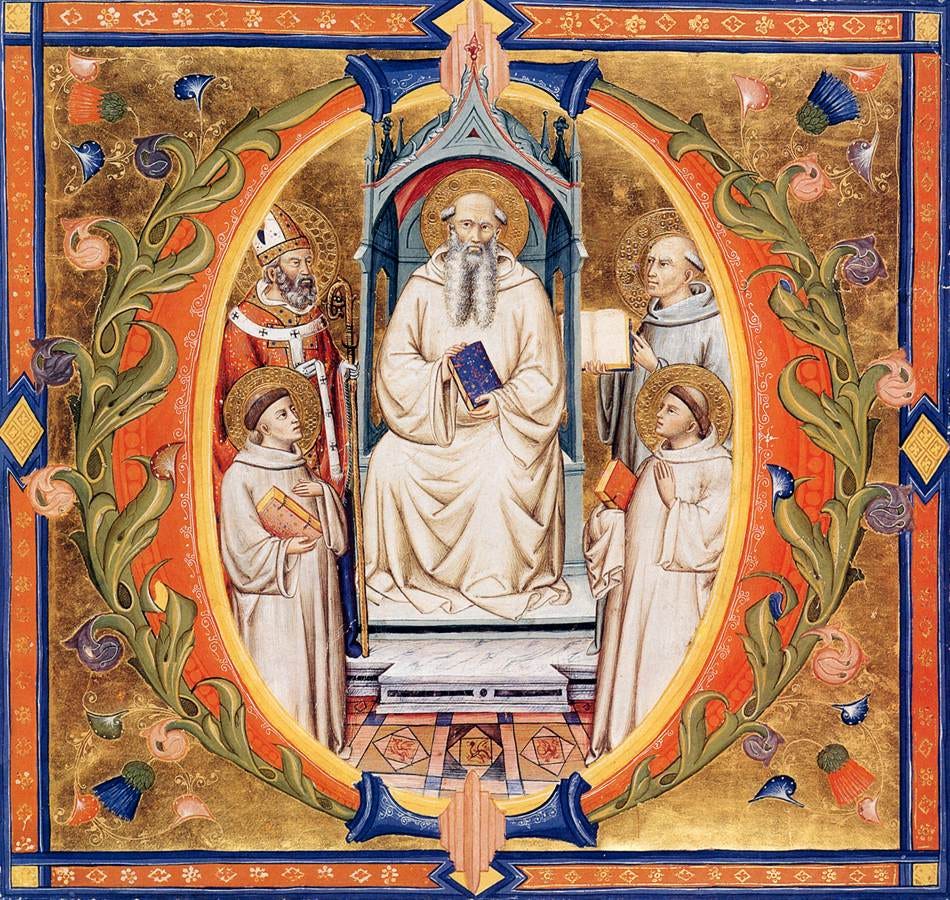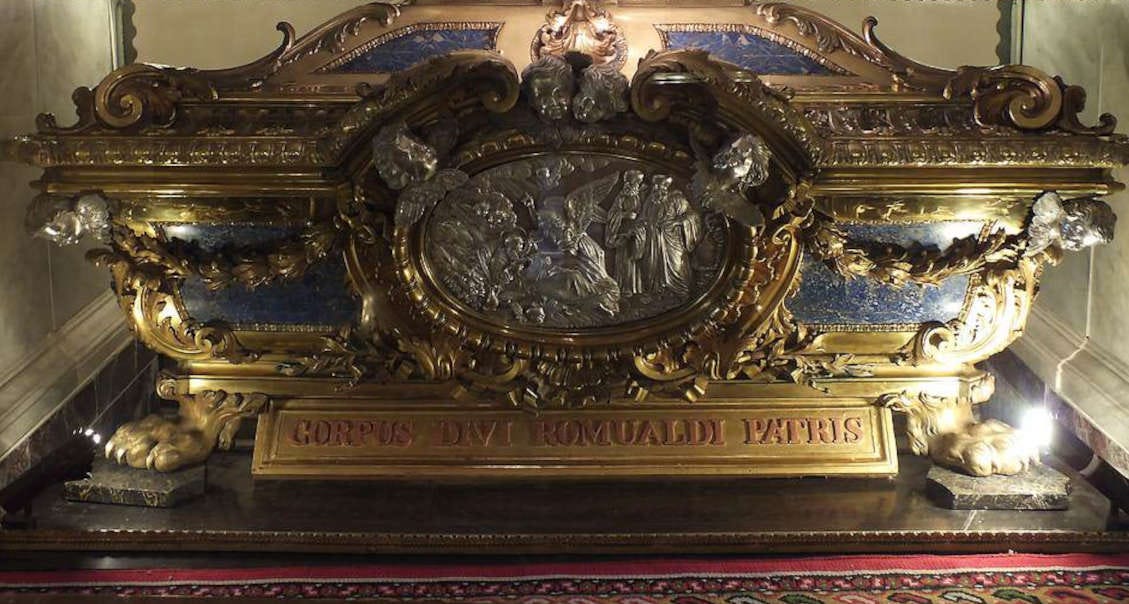St. Romuald
Born: Ravenna, probably about 950. Died: Val-di-Castro, June 19, 1027. Founder of the Camaldolese Order.
Romuald was from the Honesti family, dukes of Ravenna, Italy, and was raised in luxury and idleness. He soon found this life wanting, and while hunting would often seek out quiet places to pray, longing to be a hermit. When he was 20, his father, Sergius, fell into a dispute with a kinsman over an estate, and challenged him to a duel. Romuald was pressed into service as his father’s second. When the kinsman was slain, Romuald was filled with remorse for his complicity in the death, and fled to the nearby Benedictine monastery of Sant’Apollinare in Clasis to do penance. (His father would also later retreat to monastic life as penance.)
He was admitted to the order, but when his extreme asceticism and piety clashed with the monks’ slack observance of the Rule of Benedict, they plotted to kill him. Once again, he fled, living a peripatetic, hermetical life while founding small hermitages. Eventually, another group of the faithful plotted to kill him, but this time out of extreme affection. They didn’t want him to leave, so they decided to murder him instead. This way, at least they’d be able to keep his body and Romuald would be them forever. After learning of the plot, he emulated King David and feigned madness, causing everyone to lose respect for him and let him go on his way.
Eventually, he founded his chief hermitage in Camaldoli, in the Tuscan hills, which eventually grew into an order: the Camaldolese Hermits of Mount Corona (OSB Cam.). In a vision, he saw Jacob’s Ladder, and his monks dressed in white climbing up and down to heaven. This led him to adopt the distinct white Camaldolese habit.
The Camaldolese thrived for a time, and were an influence on monasticism in Europe, but eventually declined and now count fewer than a hundred members worldwide. They maintain a presence in California, with the New Camaldoli Hermitage in Big Sur, Incarnation Monastery in Berkeley and the Monastery of the Risen Christ in San Luis Obispo, none of which appear to be producing vocations. This interview with the former superior at the New Camaldoli Hermitage provides some unintended insight into the order’s decline.
Romuald died in 1027, and his life was written only fifteen years later by the great St. Peter Damian: Doctor of the Church, copious correspondent1, and scourge of sodomites. This section of the Vita has two interesting aspects: First, there’s the story of the relic (a scrap of Romuald’s hairshirt) which drove a demon screaming from a church. Second, there’s the matter of his incorruptible body, which was first noted five years after his death, while Peter Damian was still alive. A monk was sent to collect enough wood for a small box to hold the dust and bones of Romuald, when the saint appeared in a vision and said they’d need a bigger box.
Joan Carroll Cruz notes that “when the body of the Saint was exhumed in 1466, it was found to be incorrupt. The condition of the relic is now unknown since the last exhumation of the sacred remains occurred in 1481.” I do not know her source for this claim, but I feel like it might be time for another peak into the coffin.
Take it away, St. Peter Damian:
(70) After the most holy death of the venerable man [Romuald], God showed forth many signs of the miraculous through him. But who would wish to read about such events as have already happened, when anyone may frequently witness new miracles. Since so many miracles occur at [Romuald’s] tomb, we deem it better to pass most over in silence and to relate only a few… A certain brother, who had been a disciple of the holy man, donated a small church to the monastery for the repose of his own soul. The brother sent a piece taken from the sleeves of the hair shirt worn by the blessed man to this church and instructed that it be placed with honor under the altar. The messenger, however, neglected to place it under the altar as he had been ordered, but left it incautiously in a crack in the wall. After this had been done a certain demon came to this same church. Standing in its midst he turned his head here and there, looking over everything. He began in a dreadful manner to fasten his wild eyes with hostile intent on that very wall where the fragments of the holy hair shirt lay. Then he could not keep himself from repeatedly yelling, “He is casting me out, he is casting me out!” So exclaiming he was straightaway expelled. From this it can be concluded that there is almost nothing which cannot be brought about through the intercession of this man [Romuald] before God, since the demon was not even able to stand before the smallest fragment of his clothing. If he exhibits such marvels when he is absent, what would not be possible in the presence of his body?
(71) Five years after the death of the holy man, permission was given to the monks by the Holy See to construct an altar above his venerable body. A certain Brother Azo went into the forest in order to fashion a small coffin which would be sufficient to contain the bones and the dust of the holy confessor. When night had fallen a venerable old man appeared to another of the brother in his sleep and, interrogating him on the spot, said, “Where is the prior of this monastery?” When the monk replied that he did not know, the old man quickly responded, saying, “He has decided to go into the forest in order to fashion a coffin, but the body of the blessed man will not fit into so small a space.” The next day the prior, having finished the coffin, returned. He was asked by the brother who had seen the vision for what reason he had gone into the forest. Tired by his labor, the prior did not wish to respond. The brother, however, related to the prior both the reason for his trip and the vision which he himself had seen, narrating them in order.
(72) Therefore they opened the tomb and found that almost the entire body of the holy man was intact and preserved, just as it had been when they had originally placed it in the tomb, except that a thin sheen of liquid had appeared on certain parts of the body. Throwing away the small coffin which had already been prepared, they immediately prepared a container suited to the size of the blessed body. Placing the holy relics of their patron inside, they solemnly consecrated the altar above it.2
Ironically, Peter Damian once wrote the following, which many believe is a reference to Romuald:
I once knew a brother in Christ who followed this strict norm of constant custody over his mind, that as soon as some suggestion to impurity crept up on him, he would promptly say to himself, as if he were ready to travel, “Come, let us go to the circus.” Then, in his imagination wandering through all the cemeteries and graves, he would carefully examine the matter and corruption of decaying bodies, the crawling worms and the rot of decomposing flesh. And as he thought that this flesh, once in its prime so full of vitality, was now subject to such disaster, he concluded that his body too would be in the same condition that he now observed.3
I’ve read about half of his letters, which fill six volumes. He’s a lively writer with a colorful turn of phrase, such as: “So that we are not unaware of the devil’s clever devices, let me put before you some of the tools that he and his council have designed in his ancient laboratory of evil. (Letter 31)
Peter Damian, Vita s. Romualdi, 70–72 in Patrologia latina, ed. Jean-Paul Migne, 221 vols. (Paris, 1844–1864), 144:1006–1008. Translated by Thomas Head.
Peter Damian, Letters 121–150, trans. Owen J. Blum and Irven M. Resnick, vol. 6, The Fathers of the Church: Mediaeval Continuation (Washington, DC: The Catholic University of America Press, 2004), 60–61.








